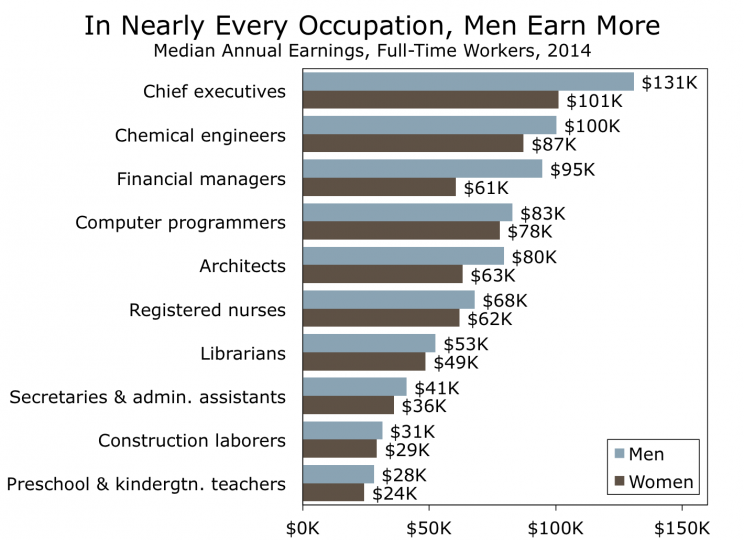The real reasons why women still earn way less than men
Over the past 50 years, women have made massive strides towards attaining economic and professional equality. Their participation in the labor market has risen, and today, many women have education equal to that of their male counterparts. Still, despite these advancements, women only earn 80 cents for every dollar a man makes — or $10,470 less annually. What gives?
To get to the bottom of this issue, Wells Fargo (WFC) released a new report that sheds light on why the gender pay gap still exists, and why closing it could benefit businesses and the economy.
Experience pays
The biggest reason for gender pay inequality has to do with participation. Wells Fargo found that 14% of the wage gap can be explained by the fact that women have less work experience. More specifically, men are able to gain more experience because once women reach their 30s, they are more likely to have young children and may choose to leave the workforce in order to deal with family obligations.
According to the National Association of Child Care Resource and Referral Agencies, the average cost of center-based childcare is $11,666 per child, per year (rates vary greatly depending on where you live). For some families, it simply doesn’t make sense for both parents to work if most of one paycheck is going towards childcare. In these instances, one parent may choose to stay home, and in the US, it is often the woman.
Another way to explain the gap in experience is to look at hours worked. For many families, both incomes are needed to keep the household financially afloat. In those scenarios, full-time married mothers still spend an hour more per day on housework and childcare than men who work full-time. Eventually, this burden becomes too much to bear, and instead of leaving the workforce altogether, a higher share of women end up working part time, in comparison to men. As a result, women work fewer hours which contributes to lower levels of on-the-job experience. Working fewer hours can also lead to a woman being under-employed, which limits the amount of skill and expertise needed for career advancement. It’s a slippery slope that starts with one important issue — lack of childcare options.
Gender roles and occupation
Millennial women were raised to believe, “Anything you can do, I can do better.” Unfortunately, women are still wildly underrepresented in some lucrative occupations, and there are still a handful of industries where men hold more employment.

For example, men are five times more likely to be engineers, and women hold less than 25% of the jobs in industries centered around computers, mathematics, engineering, farming, fishing, construction and extraction. This lack of representation is directly contributing to the gender pay gap.
The most alarming stat, however, is that men still make more money, even in female-dominated fields like nursing. According to the report, male nurses make about 10% more than female nurses.
That said, women are making strides in select industries. The report reveals that the share of women in business and financial occupations has risen 10% since 1985, with the number of women in management occupations reaching nearly 40% in 2016. Still, there is work to be done. Women are still severely underrepresented at the top of the corporate ladder, accounting for just 16% of C-suite positions (ie. CEO, CFO, etc.)
Closing the gap
The key factor keeping helping women close the pay gap is education. In the fall of 2015, women accounted for 56% of the 10.5 million students enrolled in four-year undergraduate programs. This has put the number of women with degrees on par with men, with one-third of both genders holding a bachelor’s degree or higher. If it weren’t for the increase of women getting a college education, the report states that the pay gay would be 6% larger.
Ultimately, the report found that paying women more could have two important results. In business, having a gender-diverse workforce boosts the company’s bottom line through higher sales and profits. It has also been found that having women on corporate boards is linked to stronger company performance and better company oversight.
On a bigger scale, it doesn’t take an economist to see that the more women we have engaged in the labor market, the better. If women receive higher earnings and affordable childcare options, they will be encouraged to extend their careers. This simple move would increase labor supply and boost economic growth and mobility for future generations.
Brittany is a writer at Yahoo Finance.
More:
President Trump’s child care plan does little for low-income families

